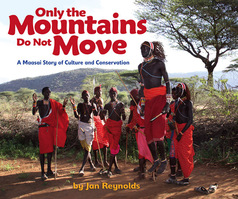TEACHER'S GUIDE FOR:
Only the Mountains Do Not Move
By Jan Reynolds
Illustrations by Jan Reynolds
Synopsis
Nobody can say he is settled
anywhere forever;
it is only the mountains
which do not move from their places.
So goes a Maasai proverb, and so goes the lives of the Maasai in Africa. For hundreds of years they have moved with their herds of cattle and goats across thousands of miles in Kenya and Tanzania.
Today the Maasai face new challenges. Their traditional way of life is threatened, lands are overgrazed, and wildlife is in danger. Maasai tribes are meeting these obstacles head-on—adapting their lives and agricultural practices while keeping their vibrant, close-knit culture alive.
Background
Traditionally the Maasai have always been a proud and independent tribe. For centuries they have lived in the heart of East Africa, in an area that covers about 100,000 square miles (161,000 square kilometers) and falls mainly in southern Kenya and northern Tanzania. The people move often, herding their cows and goats and rotating their animals to new grazing land in a balanced rhythm with the wildlife around them. The Maasai do not cultivate the land and depend on a cash economy as many of those around them do. Instead they live off the milk and meat their cattle provide. These cattle play a central role in the life of the Maasai. Cattle represent food and power; the more cattle a Maasai has, the richer he is and therefore the more power and influence he has within his tribe.
The Maasai today face many changes. The amount of grazing land is shrinking, and the land is becoming dry and barren, threatening their herds of cattle and their lifestyle. The Maasai are working to adapt to these challenges, while preserving their traditions and environment for generations to come.
Author/photographer Jan Reynolds explains her inspiration for the book. “I heard of the Il Ngwesi, which means ‘the people of wildlife,’in passing. I heard that the people were trying to maintain the environment surrounding them while also maintaining their culture. So I thought that in their area I might see more of traditional life, less affected by the outside world, as opposed to [what I might see in the] more heavily traveled national parks. I had not visited the Il Ngwesi before this book project. . . . My experience with the Il Ngwesi was so playful and fun. The people are all so grown up, but very humorous in attitude, and adventurous by nature. . . . I think we can learn from the people of Il Ngwesi that we can all change ourselves, our routines, and our habits to become more environmentally sustainable in the way we live. We can learn to maintain the balance of nature.”
| Teaching Tip Only the Mountains Do Not Move is an excellent choice to use as part of a unit on the environment and/or sustainable farming and living. |
Before Reading
Prereading Focus Questions
Before introducing the book to students, you may wish to develop background, tap prior knowledge, and promote anticipation with questions such as the following:
- What do you know about traditional life in African countries? How is this way of living different from the way people live in the United States?
- What kinds of animals live in the wild in Africa? Can you tell us the names of five African wild animals?
- Have you ever seen a live cow or goat? What can you tell us about the animal(s)? What do they need to survive?
- What do you already know about climate change? How is climate change affecting us?
- What is nonfiction? Have we read any nonfiction books? How can you tell if a book is nonfiction?
Exploring the Book
Write the title of the book on the chalkboard. Ask students what they think the title means. What do they think the book is about?
Have students look at the photographs on the front and back covers. Discuss what they notice in the images.
Read the synopsis at the beginning of this guide aloud. Then flip through the book and point out the features specific to a nonfiction book: photographs, map, author’s note, glossary and pronunciation guide, and source notes and acknowledgments. Also call students’ attention to the Maasai proverbs that appear every few pages throughout the book.
Setting a Purpose for Reading
Have students read to find out what is important to the Maasai people and why the book is entitled Only the Mountains Do Not Move.
Vocabulary
Have students turn to the Glossary and Pronunciation Guide on the last page of the book, or write the words and names, plus their pronunciations, on the chalkboard or a chart. Ask students to practice pronouncing each entry and then discuss what it means. For entries other than names, encourage students to use them in their own sentences. The entries from the Glossary are listed below. Also encourage students to use the Glossary to remind themselves of meanings they may forget as they read through the book.
| acacia | antiseptic | bao | barren | bush | |
| drought | enkaji | enkang | extinct | habitat | |
| herd | Il Ngwesi | irrigate | Laikipia | lash | |
| livestock | Maa | Maasai | manure | moran | |
| Noonkuta | oral history | overgrazing | predator | preserve | |
| Ramati | sansevieria | Washon | |||
 |
 |
 |
 |
After Reading
Discussion Questions
After students have read the book, use these or similar questions to generate discussion, enhance comprehension, and develop understanding of the content. Encourage students to refer back to the text and illustrations in the book to support their responses.
|
Literal Comprehension |
- What is an enkaji? What is an enkang? How are each important to the Maasai?
- Describe a Maasai bed. Why do the Maasai need nets around their beds? Why do you think they sleep on animal skins?
- What animals are important to the Maasai? Why?
- How do the Maasai know which animals belong to each group?
- The author talks about the important relationship the Maasai have with their animals. What are some things the Maasai do that demonstrate how special this relationship is?
- What are some dangers the Maasai face when they leave the enkang? How do the Maasai deal with these dangers?
- Describe the moran. Who are they? What do they do? Why is this an important part of the Maasai culture?
- What are five different ways acacia trees are used by people or animals?
|
Extension/Higher Level Thinking |
|

About This Title
Guided Reading:
SLexile:
990LInterest Level:
Grades 3 - 6Reading Level:
Grades 4 - 5Themes
Photographic Illustrations, Nature/Science, Nonfiction, Identity/Self Esteem/Confidence, Religion/Spiritual, Overcoming Obstacles, Occupations, Food, Farming, Environment/Nature, Cultural Diversity, Conflict resolution, African/African American Interest, Animals, Exploring Ecosystems, Informational Text, Integrity/Honesty , Optimism/Enthusiasm, Persistence/Grit, Respect/Citizenship
Collections
African American English Collection Middle School, Nonfiction Collection Middle School, English Informational Text Middle School, Fluent Dual Language , Informational Nonfiction Grades 3-6, Appendix B Diverse Collection Grades 3-6, Nonfiction Grades 3-6, Environmental Collection, High-Low Books for Preteens (Grades 4-6), African American English Collection Grades 3-6, Diverse Background English Collection Grades 3-6, Appendix B Diverse Collection Middle School, African American Collection English 6PK, English Guided Reading Level S, STEM Booklist Collection, High-Low Books for Teens: Middle and High School, Fluent English
Want to know more about us or have specific questions regarding our Teacher's Guides?
Please write us!general@leeandlow.com Terms of Use














